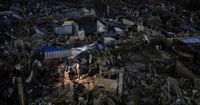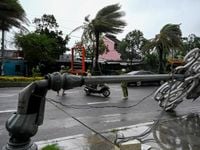Typhoon Kalmaegi, the world’s deadliest storm of 2025 so far, has left a devastating trail across Southeast Asia, battering the central Philippines before slamming into central Vietnam late Thursday, November 6. The powerful cyclone—packing sustained winds of up to 92 mph (148 km/h) and gusts even stronger—has triggered widespread destruction, mass evacuations, and a desperate scramble for relief in both nations.
According to the Vietnamese National Center for Hydro-Meteorological Forecasting, Kalmaegi made landfall near the provinces of Dak Lak and Gia Lai, churning up waves as high as 33 feet (10 meters) and unleashing a storm surge of up to two feet. The Ministry of Natural Resources and Environment warned of winds strong enough to tear roofs from homes, uproot trees, and shatter glass panels in buildings. As the storm crashed into the coast, residents like Vu Van Hao in Gia Lai told AFP, “The wind is so so strong, nothing can resist. We here have never experienced such strong wind like this. It’s a natural disaster, what can we do?”
Vietnam’s Prime Minister and Deputy Prime Minister Tran Hong Ha called on emergency response agencies and ministries to treat Kalmaegi as “urgent and dangerous.” More than 268,000 soldiers were placed on standby for search and rescue operations, and authorities ordered the evacuation of over 260,000 people in Gia Lai province alone. Schools in Gia Lai and Quang Ngai provinces were closed through Friday, six airports shut down, and hundreds of flights canceled as the country braced for the storm’s full impact.
The timing could hardly have been worse. Vietnam’s central provinces were already reeling from record rainfall in late October that caused severe flooding, killed at least 35 people, and triggered more than 150 landslides. The Environment Ministry reported that over 100,000 homes had been flooded and 2,200 hectares (5,400 acres) of crops ruined. With infrastructure weakened by these earlier disasters, the risk of further flash floods and landslides loomed large. The U.S. Consulate in Vietnam cautioned that “infrastructure already weakened by previous flooding may be increasingly unreliable.”
As Kalmaegi barreled in, power outages swept through several provinces and major cities—including Danang and Ho Chi Minh City—faced heightened flooding threats. Authorities in Quy Nhon city went door to door, urging families to flee rising waters. The storm’s arrival marked the 13th typhoon or tropical storm to hit Vietnam in 2025, exceeding the country’s usual annual average of ten such events.
The Philippines, meanwhile, was still in the throes of disaster as Kalmaegi—known locally as Tino—swept across eight central regions on Tuesday, November 4. The typhoon unleashed torrential rains and flash floods, leaving at least 142 people dead and another 127 missing, according to official figures cited by AFP and Al Jazeera. The Philippine News Agency reported that most fatalities were due to fallen debris, landslides, and flooding. In a tragic twist, six Philippine Air Force personnel lost their lives in a helicopter crash during a humanitarian mission on the same day.
Scenes of destruction emerged from Cebu province, where more than 200,000 people had been evacuated ahead of the storm. Floodwaters described as “unprecedented” swept through towns, carrying away cars, riverside shanties, and even shipping containers. “The challenge now is debris clearing,” senior civil defence official Raffy Alejandro told DZBB radio. “These need to be cleared immediately, not only to account for the missing who may be among the debris or may have reached safe areas but also to allow relief operations to move forward.”
Survivors shared harrowing stories. In Liloan, near Cebu City, Christine Aton and her father escaped through a window as floodwaters engulfed their home, unable to save her disabled sister trapped inside. Chyros Roa, another resident, credited his family’s survival to their dog’s frantic barking, which woke them just in time to climb onto their roof. “The current was really strong. We tried to call for rescue, but no one came. We were told the rescuers were swept away by the current,” Roa told AFP.
President Ferdinand R. Marcos Jr. declared a state of national calamity on Thursday, enabling the government to expedite emergency funds and impose price controls on essential goods. “Declaring a national emergency will give the government quicker access to some of the emergency funds and prevent food hoarding and overpricing,” Marcos told reporters. The Philippines faces an average of 20 typhoons per year—more than any other country—and officials warned that Kalmaegi’s devastation may not be the last. The Philippine Atmospheric, Geophysical, and Astronomical Services Administration (PAGASA) said another storm, internationally known as Typhoon Fung-wong and locally as Uwan, was gathering strength and could become a super typhoon by Saturday, November 8. “It could enter the Philippine Area of Responsibility late on Friday or early Saturday, and has an increasing chance of landfall in northern or central Luzon,” PAGASA said.
Kalmaegi’s impact in the Philippines has been staggering. More than 500,000 people remain displaced, and the arduous process of cleaning up and searching for the missing continues. The storm’s rainfall in Cebu was 1.5 times what the province typically receives in a full November—a level that meteorologist Benison Estareja told AFP happens “once every 20 years.” The highly urbanized nature of Cebu’s communities, with their dense populations and vulnerable infrastructure, made the disaster even deadlier.
As the typhoon moved on to Vietnam, forecasters warned that it could dump more than 24 inches of additional rain in some areas, with the risk of deadly landslides and flash floods compounding an already dire situation. Deputy Prime Minister Tran Hong Ha called Kalmaegi “a very abnormal” storm, and local authorities in cities like Quy Nhon scrambled to evacuate residents from low-lying and coastal areas.
Vietnam is no stranger to tropical cyclones—its central region is among the most active on Earth—but the back-to-back disasters of late October’s floods and Kalmaegi’s landfall have tested the country’s disaster response to the limit. The government’s rapid mobilization of soldiers, emergency responders, and evacuation orders has been critical in limiting the loss of life, but the full extent of the storm’s damage is still being assessed.
The twin disasters in the Philippines and Vietnam are sobering reminders of the growing risks posed by climate change. Scientists warn that warming oceans and rising global temperatures are fueling more intense storms, with heavier rainfall and higher winds. As communities from Cebu to Gia Lai struggle to recover, the specter of another super typhoon on the horizon is a harsh signal that the cycle of destruction may not be over yet.
For the millions affected, the coming weeks will be a test of resilience, solidarity, and the capacity of governments to respond to a relentless string of climate-driven catastrophes. The world is watching—and waiting—as Southeast Asia braces for what may come next.






